Why? I’m highly susceptible to Ghost in the Shells. Mamoru Oshii’s movies and Masamune Shirow’s manga loomed large over my time as a teenage anime nerd, and only a small speck of my fondness for them stems from nostalgia. That speck would be the afternoon back in 1996 when I checked all over town for the original Ghost in the Shell film and eventually found a shelf full of it at Media Play, which had apparently looted every other video store. I miss Media Play.
On its own merits, the original Ghost in the Shell became a film I return to over and over like a kid rewatching Disney movies. It’s on my list of old reliables, right there with The Adventures of Baron Munchausen, Watership Down, Mad Max: Fury Road, Dune, and, uh, Jason X. I’ll explain that last one someday.
So I was unafraid of wasting money and two hours on a potentially bad movie. It wouldn’t change the Ghost in the Shells that I liked, and it probably wouldn’t be the nadir of the whole series.

And I can say this much: the 2017 live-action film isn’t the most aggressively bad part of Ghost in the Shell history. Yet it could be the blandest. That might be worse.
Rupert Sanders’ film starts at the same core as most things Ghost in the Shell, but it diverges soon. In a relatively near future where cybernetic enhancements redefine humanity, we meet an elite operative named Major Motoko Kusanagi…oh wait, her name is Mira Killian in the live-action movie. She’s an experimental cyborg with a human brain in an entirely artificial body, and she has only dim memories of her parents dying when she was young. She works for a government cadre named Section 9, and their latest case tracks a shadowy terrorist named Kuze. Yet the clues lead deep into Hanka Robotics, the firm that crafted the Major in the first place.
The film dilutes itself from the start. The original Ghost in the Shell’s most interesting points come from the changes wrought by a world where fully robotic bodies are common and human brains can be hacked just like a credit card reader. Yet Sanders quickly establishes that the Major is unique, a novel harbinger of mankind’s next evolution. And so the story ditches any meditations on the varied paths human consciousness can take when corporeal limitations vanish. It's just about a cyborg woman finding out who she really is—not in the existential sense, but in the familiar memory-wiped Robocop sense.
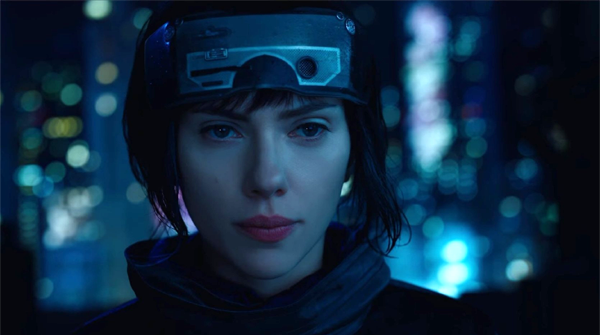
This is hardly the first movie about a superheroine manipulated by a corporation, and Sanders builds little upon it. We get a routine arc about the Major questioning her identity and discovering it again, leading to confrontations with both Kuze and a true villain both cartoonish and inconsistent. As we all know, ruthless corporate power-mongers morph into self-destructive murderers once their schemes are vaguely threatened. Such clichés are barely braced by a mundane performance by Scarlett Johansson, apparently told to act as robotic as possible, and a slightly better turn by Beat Takeshi as Section 9 chief Aramaki, whose hair doesn’t recall the anime character so much as a grayed version of Flattop from the Dick Tracy movie. They’re the highlights of the cast, too.
It may be unfair to compare the film so heavily to its anime inspiration, but Sanders clearly and desperately wants to emulate that. His film is not without some memorable action scenes, all of them swiped from the animated Ghost in the Shell: a dive off a skyscraper, an invisible takedown in a flooded courtyard, an unfortunate sanitation worker with his memories rewritten, and a showdown with an arachnid tank. Yet they’re shortened and deadened versions of the originals, rehashed here without vision or improvement.
In fact, the entire movie is truncated. Sanders is afraid to let any scene breathe, lest it go somewhere intriguing. An interlude where the Major seeks out and weirds out a fully human woman of the evening? A montage of Section 9’s members hunted by Hanka minions? Don’t let them run past a minute or two. So much of the movie is drab and mechanical, as though a longer and slightly more thoughtful picture was diced up by test screenings and producers. Perhaps that’s why the movie opens with the Major and her doctor saying “ghost” and “shell” as much as possible.
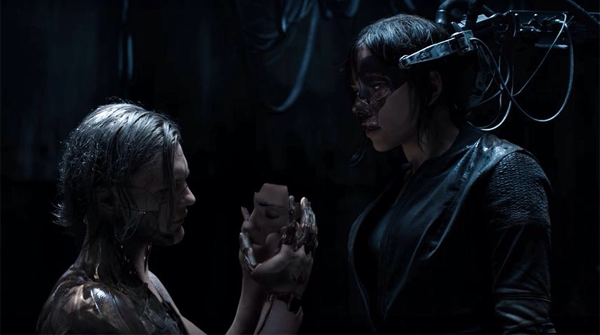
The few scenes that the movies believes in are tiresome or unintentionally hilarious. The funniest comes when Kuze reveals himself as a glitchy experiement, a turn apparently meant to be sympathetic and disturbing. Instead, he wobbles around and mutters like a cyborg version of Torgo from Manos: The Hands of Fate.
The live-action Ghost in the Shell paints a cyberpunk future with occasional flourish, even if it’s just Blade Runner during the daytime. Giant hologram commercials beckon from futuristic skyscrapers, but gray dominates much of the cityscape. Like so much else about the movie, it’s a blander version of its source material. The Wachowskis’ Speed Racer fashioned a dizzying live-action cartoon that captured the spirit of its base elements without lapsing into irrelevant tributes. Sanders’ Ghost in the Shell is the opposite, emulating its anime origin in looks but never in appeal.
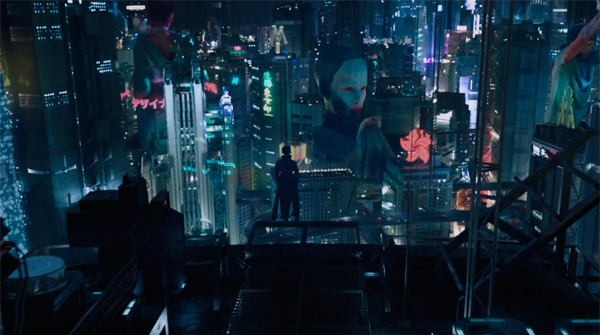
What nice things can I say about the movie? Well, the red-and-black poster is nice. There’s a basset hound, in tribute to Mamoru Oshii’s favorite dog. Beat Takeshi gets a decent shootout. The film adds a woman named Ladriya to Section 9, and Ghost in the Shell always suffered from a lack of female characters. And I didn’t hate the movie as much as I hated the Ghost in the Shell 2: Man-Machine Interface manga or the second episode of Ghost in the Shell: Arise.
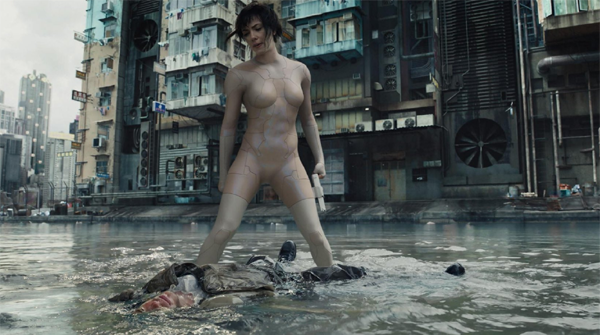
Now, you’re free to point out that Oshii’s Ghost in the Shell movies are frequently drab and downbeat, but they’re also far more self-assured. They want to be gloomy and subdued and perhaps just a bit pretentious, and they can afford to go that route because there’s always a point. Sanders’ Ghost in the Shell doesn’t really know what it wants apart from a Hollywood-sized version of a cult anime’s audience, and it expects that just for showing up and sticking Scarlett Johansson in a high-tech bodysuit.
On that subject, this particular Ghost in the Shell might be remembered most for its casting controversies. Putting Johansson in the role of a Japanese woman (and changing her name, too) did not sit well in many sectors, and the actual film twists the whitewashing allegations even further in its big predictable plot twist.
Want to hear it? OK. Before having her memory wiped and her brain ported to a high-end Johansson android, the Major was just a teenage runaway and technological dissident named…Motoko Kusanagi! Yes, the film itself is about a Japanese woman turned white. It’s so blatant that I expected the story to use it somehow, to criticize the way a corporation erased an Asian rebel and replaced her with a marketable white lady in the name of progress. Like so many other things that might interest, however, the Ghost in the Shell of 2017 does nothing with it.
That remains the live-action Ghost in the Shell’s only interesting point: building a standard action-heroine movie so bland that it’s unaware of its own criticisms. There’s no other reason to see it. Taken on its own, it’s one big, banal action-heroine cliché. Taken with the rest of the series, it’s a wan simulacrum. The original Ghost in the Shell movie came out over 20 years ago. It’s easy to find. Most of the people interested in watching it have watched it already. And in doing so, they’ve seen better versions of the best parts of the live-action Ghost in the Shell.
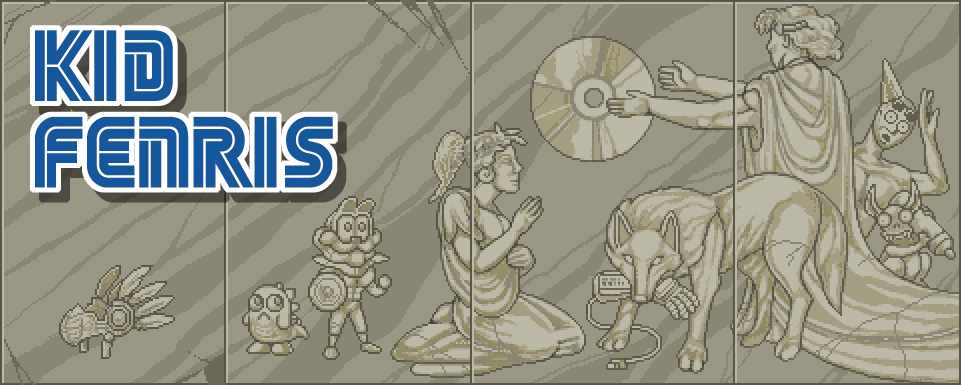
Any way your themes are nice one. Good topic. From your post I could understand that you have well idea. You have to try to add more creativeness’s in your post. It will soon attract any reader. There are some different types of writing technique such as style, design, and format. If you include all these styles you can make your blog more attractively.
ReplyDeleteYou pretty much nailed it: a watered down version of the source material that has been stripped of any intellectual or philosophical elements, while the scenes ripped from the original film are generic feeling and feel forced, but seem to never quite hit their mark, and fall flat. The copied scenes come across as blatant pandering that fall flat due to the lack of any context, and feel forced and lack feeling. Sure, its flashy, and if you turn off your brain, tilt your head and squint real hard while telling yourself it isnt Ghost In The Shell, you manage to get a bargain bin action film. I wanted to like it, I really did, but I just couldnt fool myself into believing it to be redeemable. Now you have me wondering if the film really was edited to hell and back, dumbed down purposely, and that some scenes providing insight were left on the cutting room floor. I had to sit through Sanders last film The Huntsman unfortunately, and it seems like this guy only knows how to make things look like they might be cool, but has no clue how to weave in a story worth paying attention to. Anyways, I totally miss you doing The X Button column. I read nearly everything you ever wrote for ANN throughout the years, and am always checking this site. Keep up the good work, and sorry for taking so long to voice my support. You brought so many interesting titles to my attention throughout the years, provided insightful and hilarious commentary, and shed light on many an obscure game. Many of the games you have mentioned as you favorites run parallel with my interests as well, and I really appreciate everything you have written. Thanks again, and keep up the good work! Valkyrie Profile Forever!!!!
ReplyDeleteThanks for the kind words, Tristan! I'm planning to expand this site a little in the coming months, so keep reading!
ReplyDeleteValkyrie Profile forever!